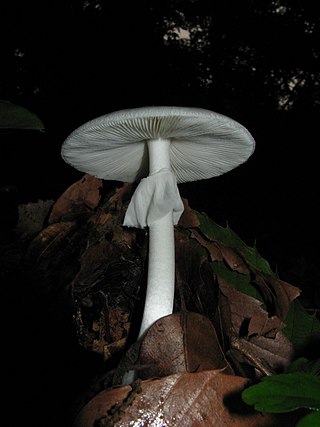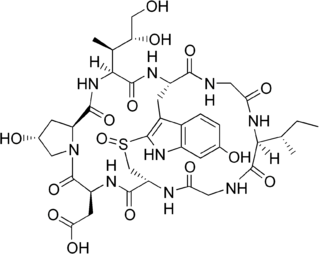
Amanita phalloides, commonly known as the death cap, is a deadly poisonous basidiomycete fungus, one of many in the genus Amanita. Widely distributed across Europe, but introduced to other parts of the world since the late twentieth century, A. phalloides forms ectomycorrhizas with various broadleaved trees. In some cases, the death cap has been introduced to new regions with the cultivation of non-native species of oak, chestnut, and pine. The large fruiting bodies (mushrooms) appear in summer and autumn; the caps are generally greenish in colour with a white stipe and gills. The cap colour is variable, including white forms, and is thus not a reliable identifier.

The genus Amanita contains about 600 species of agarics, including some of the most toxic known mushrooms found worldwide, as well as some well-regarded edible species. The genus is responsible for approximately 95% of fatalities resulting from mushroom poisoning, with the death cap accounting for about 50% on its own. The most potent toxin present in these mushrooms is α-Amanitin.

α-Amanitin (alpha-Amanitin) is a cyclic peptide of eight amino acids. It is possibly the most deadly of all the amatoxins, toxins found in several species of the mushroom genus Amanita, one being the death cap as well as the destroying angel, a complex of similar species, principally A. virosa and A. bisporigera. It is also found in the mushrooms Galerina marginata and Conocybe filaris. The oral LD50 of amanitin is 100 μg/kg for rats.

Amanita pantherina, also known as the panther cap, false blusher, and the panther amanita due to its similarity to the true blusher, is a species of fungus found in Eurasia with poisonous and psychoactive properties.
Gyromitrin is a toxin and carcinogen present in several members of the fungal genus Gyromitra, like G. esculenta. Its formula is C4H8N2O. It is unstable and is easily hydrolyzed to the toxic compound monomethylhydrazine CH3NHNH2. Monomethylhydrazine acts on the central nervous system and interferes with the normal use and function of vitamin B6. Poisoning results in nausea, stomach cramps, and diarrhea, while severe poisoning can result in convulsions, jaundice, or even coma or death. Exposure to monomethylhydrazine has been shown to be carcinogenic in small mammals.

Mushroom poisoning is poisoning resulting from the ingestion of mushrooms that contain toxic substances. Symptoms can vary from slight gastrointestinal discomfort to death in about 10 days. Mushroom toxins are secondary metabolites produced by the fungus.

Amanita virosa, commonly known in Europe as the destroying angel or the European destroying angel amanita, is a deadly poisonous basidiomycete fungus, one of many in the genus Amanita. Occurring in Europe, A. virosa associates with various deciduous and coniferous trees. The large fruiting bodies appear in summer and autumn; the caps, stipes and gills are all white in colour.

Ibotenic acid or (S)-2-amino-2-(3-hydroxyisoxazol-5-yl)acetic acid, also referred to as ibotenate, is a chemical compound and psychoactive drug which occurs naturally in Amanita muscaria and related species of mushrooms typically found in the temperate and boreal regions of the northern hemisphere. It is a prodrug of muscimol, broken down by the liver to that much more stable compound. It is a conformationally-restricted analogue of the neurotransmitter glutamate, and due to its structural similarity to this neurotransmitter, acts as a non-selective glutamate receptor agonist. Because of this, ibotenic acid can be a powerful neurotoxin in high doses, and is employed as a "brain-lesioning agent" through cranial injections in scientific research. The neurotoxic effects appear to be dose-related and risks are unclear through consumption of ibotenic-acid containing fungi, although thought to be negligible in small doses.
Amatoxin is the collective name of a subgroup of at least nine related toxic compounds found in three genera of poisonous mushrooms and one species of the genus Pholiotina. Amatoxins are very potent, as little as half a mushroom cap can cause severe liver injury if swallowed.

Amanita cokeri, commonly known as Coker's amanita and solitary lepidella, is a poisonous mushroom in the family Amanitaceae. First described as Lepidella cokeri in 1928, it was transferred to the genus Amanita in 1940.

Amanita verna, commonly known as the fool's mushroom or the spring destroying angel, is a deadly poisonous basidiomycete fungus, one of many in the genus Amanita. Occurring in Europe in spring, A. verna associates with various deciduous and coniferous trees. The caps, stipes and gills are all white in colour.

Amanita ocreata, commonly known as the death angel, destroying angel, angel of death or more precisely western North American destroying angel, is a deadly poisonous basidiomycete fungus, one of many in the genus Amanita. The large fruiting bodies generally appear in spring; the cap may be white or ochre and often develops a brownish centre, while the stipe, ring, gill and volva are all white. A. ocreata resemble several edible species commonly consumed by humans, increasing the risk of accidental poisoning. Mature fruiting bodies can be confused with the edible A. velosa, A. lanei or Volvopluteus gloiocephalus, while immature specimens may be difficult to distinguish from edible Agaricus mushrooms or puffballs.

β-Amanitin (beta-Amanitin) is a cyclic peptide comprising eight amino acids. It is part of a group of toxins called amatoxins, which can be found in several mushrooms belonging to the genus Amanita. Some examples are the death cap and members of the destroying angel complex, which includes A. virosa and A. bisporigera. Due to the presence of α-Amanitin, β-Amanitin, γ-Amanitin and epsilon-Amanitin these mushrooms are highly lethal to human beings.

Amanita abrupta, commonly known as the American abrupt-bulbed amanita or the American abrupt-bulbed lepidella, is a possibly toxic species of fungus in the family Amanitaceae. Named for the characteristic shape of its fruit bodies, this white Amanita has a slender stem, a cap covered with conical white warts, and an "abruptly enlarged" swollen base. This terrestrial species grows in mixed woods in eastern North America and eastern Asia, where it is thought to exist in a mycorrhizal relationship with a variety of both coniferous and deciduous tree species.

Amanita onusta, commonly known as the loaded Lepidella, the gunpowder Lepidella or the gunpowder amanita, is a species of fungus in the mushroom family Amanitaceae. It is characterized by its small to medium-sized fruit bodies that have white to pale gray caps crowded with roughly conical, pyramidal, or irregular gray warts. The stipe is whitish-gray with woolly or wart-like veil remnants, and at the base is a spindle- or turnip-shaped base that is rooted somewhat deeply in the soil.

Amanita exitialis, also known as the Guangzhou destroying angel, is a mushroom of the large genus Amanita. It is distributed in eastern Asia, and probably also in India where it has been misidentified as A. verna. Deadly poisonous, it is a member of section Phalloideae and related to the death cap A. phalloides. The fruit bodies (mushrooms) are white, small to medium-sized with caps up to 7 cm (2.8 in) in diameter, a somewhat friable ring and a firm volva. Unlike most agaric mushrooms which typically have four-spored basidia, the basidia of A. exitialis are almost entirely two-spored. Eight people were fatally poisoned in China after consuming the mushroom in 2000, and another 20 have been fatally poisoned since that incident. Molecular analysis shows that the species has a close phylogenetic relationship with three other toxic white Amanitas: A. subjunquillea var. alba, A. virosa and A. bisporigera.

Amanita rubrovolvata, commonly known as the red volva amanita, is a species of fungus in the family Amanitaceae. The fungus produces small to medium-sized mushrooms, with reddish-orange caps up to 6.5 millimetres wide. The stems are up to 10 cm (4 in) tall, cream-coloured above the ring and cream to yellowish below it. The stem ends in a roughly spherical bulb at the base, which is covered with bright orange patches.

Amanita muscaria var. formosa, known as the yellow orange fly agaric, is a hallucinogenic and poisonous basidiomycete fungus of the genus Amanita. This variety, which can sometimes be distinguished from most other A. muscaria by its yellow cap, is a European taxon, although several North American field guides have referred A. muscaria var. guessowii to this name. American mycologist Harry D. Thiers described a yellow-capped taxon that he called var. formosa from the United States, but it is not the same as the European variety. The Amanita Muscaria is native to temperate or boreal forest regions of the Northern Hemisphere. However, it has also been introduced in New Zealand, Australia, South America, and South Africa.

















